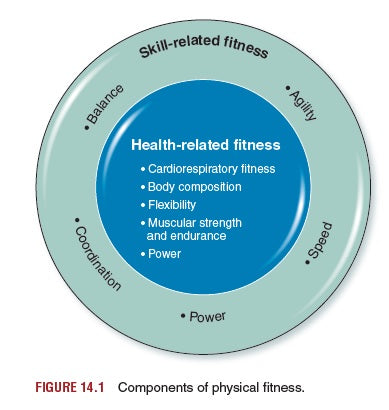Health-Related Fitness, Skill-Related Fitness, & Manipulative Skills
By Dr. Robert Pangrazi, Human Kinetics Author, Professor Emeritus ASU
JUNE 2019
Physical fitness is often measured to see if an adequate standard is in place to ensure good health. The general definition of physical fitness is offered by Howley & Franks (2007) as “a state of well-being with a low risk of premature health problems and energy to participate in a variety of physical activities.”
The two types of physical fitness most often identified are health-related physical fitness and skill-related physical fitness. The difference between functional fitness (health related) and fitness related to athletic ability (skill related) is shown in Figure 14.1.

Health-related fitness is characterized by moderate to vigorous physical activity. Health-related fitness is a better match for people who are generally unwilling to exercise at high intensities. Health-related fitness activities can be integrated into everyday activities that are often characterized as lifetime activities. In contrast, skill-related physical fitness includes health-related components, but it also covers components related to physical performance. Skill-related fitness is the right choice for people who can and want to perform at a high level, but it is less acceptable to most people because it requires training and exercising at high intensities. (The above is an excerpt taken from Dynamic Physical Education for Elementary School Children-19th Edition.)
Fitness Games and Challenges
Combining locomotor skill practice with strength and flexibility exercises addresses components of both health-related and skill-related fitness. Try alternating simple games with fitness challenge activities in your classes. Fitness challenges are modifications of exercises older students perform. For an example, read this written description of the challenges and watch this four-minute video of the challenges being performed by a class.
Manipulative Skills
To further develop skill-related physical fitness, work on manipulative skills, activities that help children handle an object with their hands, feet, or other body parts. These are complex motor patterns for which general developmental stages have been identified, from initial stages through mature performance patterns. Most complex skills should be practiced at normal speed. Although locomotor skills can be slowed down to promote learning, doing so with complex skills such as throwing, striking, or kicking destroys the rhythm of the skills. Consider the following lesson plans for basketball manipulative skills:
View Grades K - 2 Lesson Plans
View Grades 3 - 4 Lesson Plans
View Grades 5 - 6 Lesson Plans
If you use music in your lessons, during skill practice is a good time to turn it off. Remember the 3 R's of skill learning: Repetition, Refinement, and Reflection. Music can detract from reflection and focused practice. Use drills to apply the skills your students have learned. Drills should be done with little or no competition, so the focus is on technique.
Within the lesson, include a lead-up game where students can use the skills they have learned. Above all, assure that all students get to play all positions, accumulate the same number of repetitions, and are placed in an enjoyable environment. Put skills, drills, and lead-up activities together for successful learning of all manipulative activities.
 Bob Pangrazi, PhD, taught for 31 years at Arizona State University in the department of exercise science and physical education and is now a professor emeritus. He is a best-selling author of numerous books and texts over the years, including multiple editions of Dynamic Physical Education for Elementary School Children. This text is made even more practical in release of the 19th edition with the free interactive website Dynamic PE ASAP.
Bob Pangrazi, PhD, taught for 31 years at Arizona State University in the department of exercise science and physical education and is now a professor emeritus. He is a best-selling author of numerous books and texts over the years, including multiple editions of Dynamic Physical Education for Elementary School Children. This text is made even more practical in release of the 19th edition with the free interactive website Dynamic PE ASAP.

Latest Posts
- Live Well Foundations of High School Health Teacher Collection
- Live Well Foundations of High School Health Bundle
- Live Well Foundations of High School Health Interactive Web Text
- Review of Adapted Physical Activity Across the Life Span
- Supporting Mental Health through Movement
- A Dozen Reason for Including Conceptual Physical Education in a Quality Secondary Program


